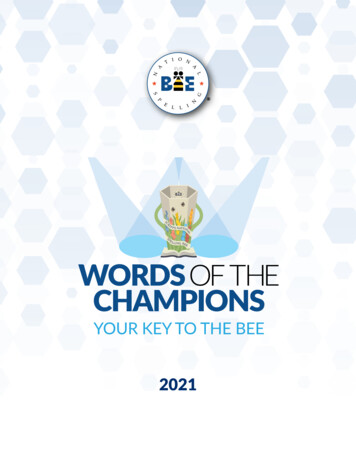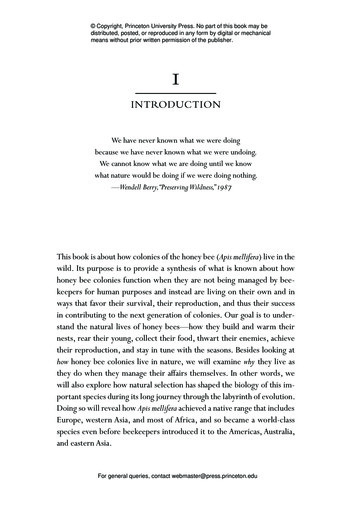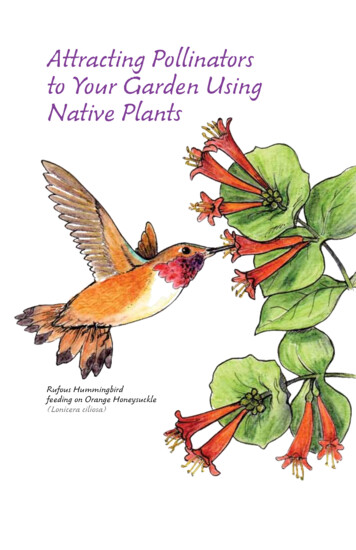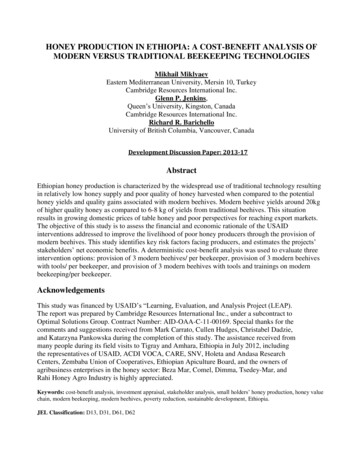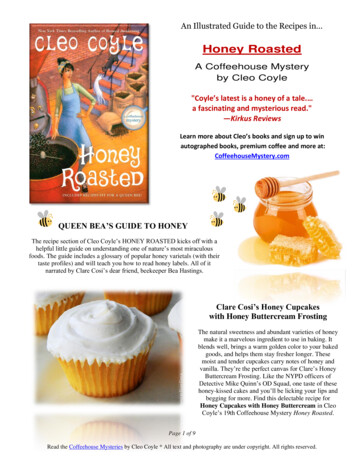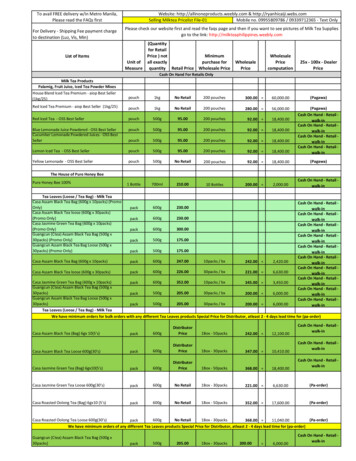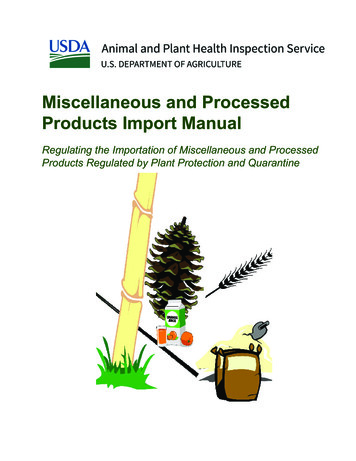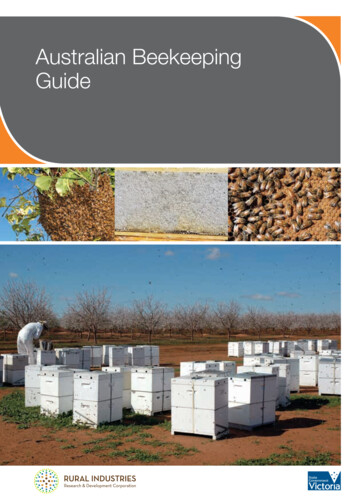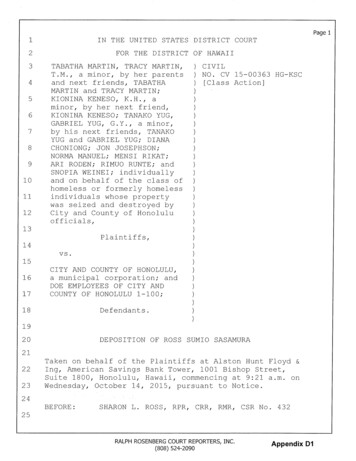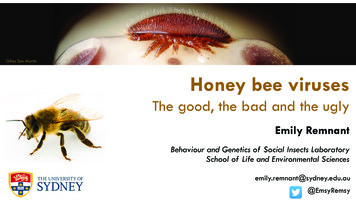
Transcription
Gilles San MartinHoney bee virusesThe good, the bad and the uglyEmily RemnantBehaviour and Genetics of Social Insects LaboratorySchool of Life and Environmental Sciencesemily.remnant@sydney.edu.au@EmsyRemsy
/https://www.facebook.com/sydneybeelab/
Honey bees in decline UNEP 2010 - UNEP Emerging Issues: Global Honey Bee Colony Disorder and Other Threats to Insect Pollinators
Factors affecting honey bee healthTrapp, J., et al 2017 Genomics, transcriptomics and proteomics: enabling insights into social evolution and disease challenges for managed and wild bees. Mol Ecol 26(3): 718-739.
What can we do about bee disease?Parasites and pathogens are a major cause of colony lossand suboptimal honey bee healthAre there genetic mechanisms that could reduce the impact ofviruses in honey bees?
The power and promise of genomics forhoney bee healthDiseaseDiagnosisBreeding healthy beesImmunity and ResiliencePathogen DiscoveryPathogen DefenceGrozinger, C. M. and G. E. Robinson (2015). "The power and promise of applying genomics to honey bee health." Curr Opin Insect Sci 10: 124-132.
My goals1. Understand the impact of new pests and diseaseson honey bees2. Investigate methods to improve honey bee health
Infect all cellular forms of lifeAbundantDiverseRapidly y/Resource/6716/digital first content/trunk/test/hillis2e/hillis2e ch19 5.html
VirusCell
Virus genomes come in different flavoursGENOMERNA or DNARNA:RiboNucleic AcidDNA:DeoxyriboNucleic AcidSingle-strandednegative-sense RNASingle-strandedpositive-sense RNASinglestrandedDNADouble-stranded DNAeg. Influenza,Ebolaeg. Dengue feverCommon coldeg. HerpesSmallpox
Honey bee virusesBlack queen cell virusBQCV Black queen cell virus Historically 24 viruses Australia has 5 common viruses New viruses being discoveredIAPV Israeli acute paralysis virusSBPVSlow bee paralysis virus Lake Sinai Virus 1 and 2Sacbrood virus DWVSBVDeformed wing virusSacbrood virusSpurny et al 2017 J Virol 91(6); Prochazkova et al 2018 PNAS 115(30); Škubník et al 2017 PNAS 114(12); Kalynych et al, 2016 J Virol 90(16); Mullapudi, et al, 2016 J Virol 90(18)
Honey bee virusesDeformed Wing virusVarroa destructor virus 1Kakugo virusNilaparvata lugens honeydew virus-3Thaumetopoea pityocampa iflavirus 1Lymantria dispar iflavirus 1Antheraea pernyi iflavirusSlow Bee Paralysis VirusGraminella nigrifrons virus 1Laodelphax striatellus picorna-like virus 2Laodelphax striatella honeydew virus 1Nilaparvata lugens honeydew virus-1Nilaparvata lugens honeydew virus-2Lygus lineolaris virus 1Sacbrood virusHalyomorpha halys virusBombyx mori Infectious flacherie virusSpodoptera exigua iflavirus 1Perina nuda virusEctropis obliqua picorna-like virusSpodoptera exigua iflavirus 2Himetobi P virusCripavirus NB-1Black Queen Cell VirusTriatoma virusPlautia stali intestine virusHomalodisca coagulata virus-1Israeli Acute Paralysis VirusKashmir Bee VirusFormica exsecta virus 1Acute Bee Paralysis virusSolenopsis invicta virus 1Cricket Paralysis virusDrosophila C virusApis C virus AWDAphid Lethal Paralysis virusRhopalosiphum padi virusMacrobrachium rosenbergii Taihu virusTaura syndrome virusMud crab dicistrovirusDeformed Wing VirusIflaviridaeSlow Bee Paralysis VirusSacbrood VirusDicistroviridaeBlack queen cell virusAcute Bee Paralysis VirusSingle-strandedpositive-sense RNA
Virus ClassificationGenome typeSingle-strandednegative-sense RNADeformed wing virusSingle-strandedpositive-sense RNASinglestrandedDNADouble-stranded DNAHoney beesInsects 22 2
Who’s really in control?Us?ParasitesBacteriaViruses
The MicrobiomeWe are FULL ofmicroorganismsthat impact how ourbody works
The MicrobiomeSome BadSome Good
What’s living inside our bees?The good, the bad and the ugly
The bee gut 8-10 core species of bacteria in the gut, with key roles in health anddevelopment
Honey bee diseasesVIRUSESFUNGIDeformed wingKakugoBlack Queen CellSacbroodCloudy wingIsraeli Acute ParalysisKashmir BeeAcute ParalysisChronic ParalysisSlow paralysisetc NosemaChalkbroodBACTERIAAmerican foulbroodEuropean foulbroodBoris Yagound
Arrival of a new* pestVarroa destructor: Parasitic miteJumped from Apis cerana à Apis melliferaP. ZborowskiApis ceranaAsian honey beeApis melliferaEuropean honey bee
National Geographic Japan; https://www.youtube.com/watch?v lMtFYt7ko o
Impact of Varroa Wounding and weakening Damage to the cuticle Feeds on developing bees Vector for viruses Spreads viruses Viruses replicate in mitesGilles San Martin
We’re still learning about Varroa HOT OFF THE PRESS!! Varroa feeds on the bee’s fat body,not haemolymph (‘bee blood’) The genome of Varroa has beensequencedRamsey, S. D., et al, (2019). Varroa destructor feeds primarily on honey beefat body tissue and not hemolymph. PNAS 116(5): 1792-1801
Bees brought to their kneesViruses have changed since the arrival of VarroaThe main suspect: Deformed wing virus (DWV) Varroa arrives: DWV levels rapidly increase Left untreated for mites, hives die in 2-3 yearsDeformed wing virusVarroa destructorGilles San MartinAlex WildKlaas de Gelder
Deformed wing virus: Global pandemic
So how do we stop viruses? get rid of mites ?
Ways to get rid of mites Chemical treatments In hive residues, bad for bees Mites can become resistant Natural selection of Varroa-tolerance or resistance Over time, bees learn to live with, or get rid of, mites
Colonies can survive mite infestations withoutchemical interventionSwindon, UKGotland, SwedenAmsterdam, NetherlandsAvignon, France1. Breeding programs2. “Live and let die”Arnot Forest, USMexicoPrimorski, RussiaTunisiaCosta RicaVava’u, TongaHawaiiFernando deNoronha, BrazilBrazilKenya, Tanzania,UgandaSouth AfricaWilfert et. al, (2016) Deformed wing virus is a recent global epidemic in honeybees driven by Varroa mites. Science 351(6273), pp. 594-7Adapted from: Locke, B., 2015 Natural Varroa mite-surviving Apis mellifera honeybee populations. Apidologie: 47: 467-482.
But are there still viruses in bees thattolerate Varroa?
Colonies can survive mite infestations withoutchemical interventionSwindon, UKGotland, SwedenAmsterdam, NetherlandsAvignon, FranceArnot Forest, USMexicoPrimorski, RussiaTunisiaCosta RicaVava’u, TongaHawaiiFernando deNoronha, BrazilBrazilKenya, Tanzania,UgandaSouth AfricaNew ZealandWilfert et. al, (2016) Deformed wing virus is a recent global epidemic in honeybees driven by Varroa mites. Science 351(6273), pp. 594-7Adapted from: Locke, B., 2015 Natural Varroa mite-surviving Apis mellifera honeybee populations. Apidologie: 47: 467-482.
Finding Bees
Quarantine Approved Facility Samples are imported frozen,stored at -80º until required No infected materials leave thequarantine areas of the lab Samples are denatured, noninfectious, non-viable derivatives Waste is autoclaved anddisposed of according toquarantine approved protocols
Sequence all the genetic material inside a beeIllumina HiSeq2500( 10,000 )(5-10 beesper colony)VirusesBacteria FoodBee genesbillions ofsequencereads!! TTTTATTAAA (x millions)
7 new RNA virusesFirst negative sense RNA viruses in beesSingle-strandednegative-sense RNASingle-strandedpositive-sense RNARemnant et. al., (2017) J VirolNetherlandsSouth AfricaTongaNew ZealandApis Rhabdovirus 1 Apis Rhabdovirus 2 Apis Bunyavirus 1 Apis Bunyavirus 2 Apis C virus Apis Flavivirus Apis Nora virus
Apis Rhabdovirus 1Single-strandednegative-sense RNAGeographically widespread, multi-host virusAmsterdam, NetherlandsPennsylvania, USIsraelVava’u, TongaSouth AfricaNew ZealandRemnant et. al., (2017) Journal of Virology, 91(16); Levin et. al., (2017) Frontiers in Microbiology, 8(2482)
Virus ClassificationGenome typeSingle-strandednegative-sense RNAWe don’tknow whatthe newviruses doSingle-strandedpositive-sense RNASinglestrandedDNADouble-stranded DNAHoney beesInsects4 25 2
Virus levels in bees can be pretty high!Percent of reads aligned to ng123Mainland1234Robben IslandSouth Africa512341234Arnot ForestAfricanisedUSABrazilPopulations surviving Varroa1234Tongatapu& ‘EuaTonga123456Molokai & KauaiHawaiiVarroa- absent78
DWV is absent in some populationssurviving VarroaPercent of reads aligned to ng123Mainland1234Robben IslandSouth Africa512341234Arnot ForestAfricanisedUSABrazilPopulations surviving Varroa1234Tongatapu& ‘EuaTonga123456Molokai & KauaiHawaiiVarroa- free78
High levels of DWV in other populationssurviving VarroaPercent of reads aligned to KUSA412Populations surviving Varroa34Vava’uTonga51234Oahu & Big IslandHawaii
What can we do about it? Varroa has increased Deformed wing virus levels inbees Is that a bad thing?
Should we be worried about Deformed Wing Virus?Deformed WingVirusSacbrood & Blackqueen cell virusDWV allows pupal survival andadult emergenceRemnant et. al. (2019). Direct transmission by injection affects competitionamong RNA viruses in honeybees Proc B 286(1895): 20182452.
What can we do about it? Varroa has increased Deformed wing virus levels inbees Is that a bad thing? – PROBABLY not a good thing Long term effects on colony survival Impact of viruses remains high in most places Varroa-resistance may not be a complete solution Can we reduce virus levels in bees by other mechanisms?
Meanwhile, in other insects
What is Wolbachia?Wolbachia pipientis Bacteria that lives inside cells Infects about half of all insect species Manipulates insect hosts to increase transmission Provides resistance to viruses in flies and mosquitoesWolbachiainside an insect cell
‘Eliminate Dengue’ Dengue fever: WHO #1 mosquito-borne disease 30-fold increase in past 10 years Aedes aegypti mosquito: vector of Dengue, Chikungunya, Zika virus Use a natural mechanism to prevent spread ofDengue fever: infect mosquitoes with Wolbachia
Dengue virus levelThe Wolbachia methodStrain 1Strain 2Images: Perran RossMoreira, L. A., et al, (2009). "A Wolbachia symbiont in Aedes aegypti limits infection with Dengue, Chikungunya, and Plasmodium." Cell 139(7): 1268-1278.
Wolbachia in bees? Present in African honey bee subspecies- these bees had low virus levels Little evidence for Wolbachia elsewhere in Apis Antibiotic treatments will remove WolbachiaSouth AfricaUSAEuropeAustraliaWolbachia positiveWolbachia negativeTotal 106Total 86Total 80Can Wolbachia provide virus resistance tohoney bees?Total 71
Can we immunise honey bees with bacteria?Wolbachia experiments:- Contained in our quarantine lab- Microinjection wolbachia into honeybee eggs and queen pupae à ovaries- Does it survive?- Does it reduce viruses?WATCH THIS SPACE!2mm
Can we reduce viruses in honey bees withbacteria?
The power and promise of genomics forhoney bee health: Virus levels, strains and new viruses identified Varroa-resistant bee populations have different viruses What genes do bees use protect themselves against viruses? Can we use protective bacteria to reduce viruses in bees?Working towards new strategiesfor disease diagnosis and control
AcknowledgementsUniversity of SydneyMadeleine BeekmanBen OldroydBoris YagoundTom GillardGabriele BuchmannMichael HolmesUniversity of SalfordStephen MartinLaura BrettelJessica KevillTongaBruce WhiteLamorna OsborneNew ZealandPhil LesterJessica RussellJames BatyPeter DeardenWangeningen UniversityTjeerd Blacquièreemily.remnant@sydney.edu.au@EmsyRemsy
Thanks for listening!Questions? Comments? book.com/sydneybeelab/@EmsyRemsy
Honey bee viruses Historically 24 viruses Australia has 5 common viruses New viruses being discovered Black queen cell virus BQCV IAPV SBPV DWV SBV Israeli acute paralysis virus Slow bee paralysis virus Deformed wing virus Sacbrood virus Spurny et al 2017 J Virol 91(6); Prochazkova et al 2018 PNAS 115(30); Škubník et al 2017 PNAS 114(12); Kalynych et al, 2016 J Virol 90(16 .
